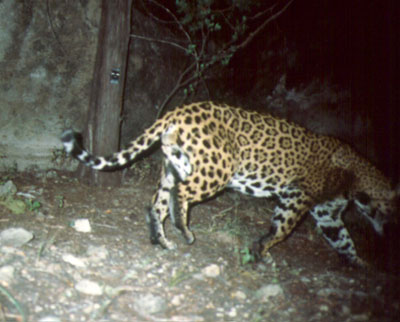

In an effort to conserve the rare endangered species, the exact location at which the photograph was taken isn't being released at this time. Surveillance cameras have been used in some locations since May 1997.
"This photograph is really exciting. It is great to know that jaguars are roaming our borderlands, at least occasionally. We will continue to monitor the area to see if the animal is a transient or attempting to establish a territory. Since we are unsure whether the animal is still in the area, there are no proposed changes for land or recreational use, " said Bill Van Pelt, Arizona Game and Fish Department's nongame mammals program manager.
Van Pelt said a Jaguar Conservation Team (JAGCT) was formed in 1997 in cooperation with residents in southern Arizona/New Mexico to gather jaguar data and monitor potential travel corridors on the borderlands. The effort in the United States has also stimulated a parallel conservation effort in Mexico. All JAGCT members, along with federal and state wildlife managers, have been notified to be on the alert and to watch for jaguar.
As part of this cooperative effort, the Malapai Borderlands Group, founded in 1997, has established a fund to cover depredation expenses if a proven jaguar livestock kill is identified.
Jaguars were placed on the federal endangered species list July 22, 1997. Illegal take of the species could result in state and federal fines of up to $100,000 fine and a year in prison.
There have been 63 jaguar sightings in Arizona since 1900. The last Arizona photograph was taken in August 1996. The closest known population of jaguars is 135 miles south, deep in the Sierra Madre of Mexico.
Jaguars (Panthera onca), which are the third largest cat in the world, are secretive cats that are muscular with relatively short limbs and a deep-chested body. They are cinnamon-buff in color with many black spots that are often broken circles or rosettes. A black or melanistic phase can occur.
Jaguars are the only cat species found in the Western Hemisphere to truly roar, like an African lion, tiger, or leopard. Historically, jaguars were found in virtually every habitat type known to Arizona and New Mexico. These habitats include everything from shrub-invaded desert grasslands to montane-conifer forest. In recent times, they have been most closely associated with evergreen-oak woodlands, extending northward from Mexico.
Jaguars once ranged from southern Argentina, up along the coasts of Central America and Mexico, and into the southwestern United States as far north as the Grand Canyon. Today, this range is greatly reduced and fragmented.
Throughout their entire range, jaguars are recognized and protected under the Convention on International Trade in Endangered Species (CITES). In the United States and Mexico, they are considered an endangered species under each country's Endangered Species Acts.
In addition, an Arizona-New Mexico Conservation Agreement, involving participation by state and federal agencies, local governments, nongovernmental entities such as the ranching community, houndsmen, and private citizens, has been established to help conserve the species. The goals of this agreement include educating the public, identifying habitat and travel corridors for population maintenance, and the development of strong public-private partnerships using innovative and adaptive management to conserve the jaguar in Arizona and New Mexico.
Recognizing the lack of information about jaguars, the team has been aggressive in collecting sound scientific data. In 1998, members from the working group traveled to Brazil to collect information on jaguar depredation on livestock and published a book on jaguar sign. Working group members are also monitoring remote census-cameras in mountain ranges recently occupied by jaguars. JAGCT is currently printing an informational brochure on jaguars.
If you see a jaguar, it is extremely important to note several things:
- Observe specifics of the area so managers can find the exact location.
- Note the specific characteristics of the animal's coloration, size, posture and behavior.
- If possible, take a photograph or video of the jaguar and the area.
- Collect any sign (scat, hair, track tracing) if possible, without destroying the integrity of the track.
- Report the sighting immediately to Van Pelt at (602) 789-3573.
Copyright © 2002 J & D Outdoor Communications. All rights reserved.